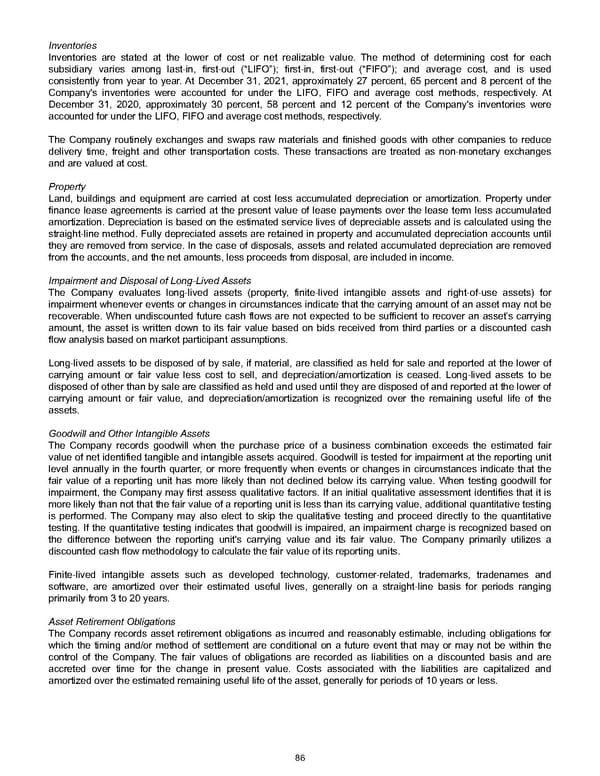Inventories Inventories are stated at the lower of cost or net realizable value. The method of determining cost for each subsidiary varies among last-in, first-out (“LIFO”); first-in, first-out (“FIFO”); and average cost, and is used consistently from year to year. At December 31, 2021 , approximately 27 percent , 65 percent and 8 percent of the Company's inventories were accounted for under the LIFO, FIFO and average cost methods, respectively. At December 31, 2020 , approximately 30 percent , 58 percent and 12 percent of the Company's inventories were accounted for under the LIFO, FIFO and average cost methods, respectively. The Company routinely exchanges and swaps raw materials and finished goods with other companies to reduce delivery time, freight and other transportation costs. These transactions are treated as non-monetary exchanges and are valued at cost. Property Land, buildings and equipment are carried at cost less accumulated depreciation or amortization. Property under finance lease agreements is carried at the present value of lease payments over the lease term less accumulated amortization. Depreciation is based on the estimated service lives of depreciable assets and is calculated using the straight-line method. Fully depreciated assets are retained in property and accumulated depreciation accounts until they are removed from service. In the case of disposals, assets and related accumulated depreciation are removed from the accounts, and the net amounts, less proceeds from disposal, are included in income. Impairment and Disposal of Long-Lived Assets The Company evaluates long-lived assets (property, finite-lived intangible assets and right-of-use assets) for impairment whenever events or changes in circumstances indicate that the carrying amount of an asset may not be recoverable. When undiscounted future cash flows are not expected to be sufficient to recover an asset’s carrying amount, the asset is written down to its fair value based on bids received from third parties or a discounted cash flow analysis based on market participant assumptions. Long-lived assets to be disposed of by sale, if material, are classified as held for sale and reported at the lower of carrying amount or fair value less cost to sell, and depreciation/amortization is ceased. Long-lived assets to be disposed of other than by sale are classified as held and used until they are disposed of and reported at the lower of carrying amount or fair value, and depreciation/amortization is recognized over the remaining useful life of the assets. Goodwill and Other Intangible Assets The Company records goodwill when the purchase price of a business combination exceeds the estimated fair value of net identified tangible and intangible assets acquired. Goodwill is tested for impairment at the reporting unit level annually in the fourth quarter, or more frequently when events or changes in circumstances indicate that the fair value of a reporting unit has more likely than not declined below its carrying value. When testing goodwill for impairment, the Company may first assess qualitative factors. If an initial qualitative assessment identifies that it is more likely than not that the fair value of a reporting unit is less than its carrying value, additional quantitative testing is performed. The Company may also elect to skip the qualitative testing and proceed directly to the quantitative testing. If the quantitative testing indicates that goodwill is impaired, an impairment charge is recognized based on the difference between the reporting unit's carrying value and its fair value. The Company primarily utilizes a discounted cash flow methodology to calculate the fair value of its reporting units. Finite-lived intangible assets such as developed technology, customer-related, trademarks, tradenames and software, are amortized over their estimated useful lives, generally on a straight-line basis for periods ranging primarily from 3 to 20 years. Asset Retirement Obligations The Company records asset retirement obligations as incurred and reasonably estimable, including obligations for which the timing and/or method of settlement are conditional on a future event that may or may not be within the control of the Company. The fair values of obligations are recorded as liabilities on a discounted basis and are accreted over time for the change in present value. Costs associated with the liabilities are capitalized and amortized over the estimated remaining useful life of the asset, generally for periods of 10 years or less. 86
 Annual Report Page 95 Page 97
Annual Report Page 95 Page 97